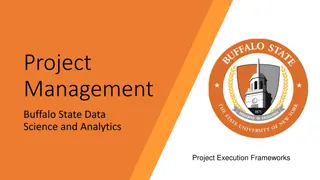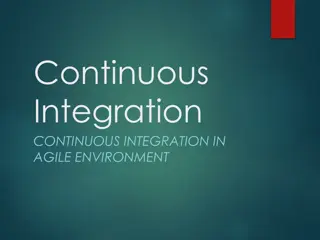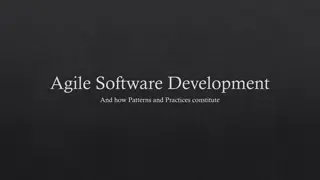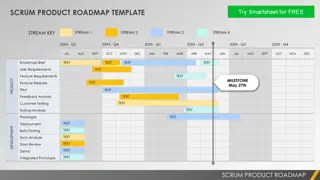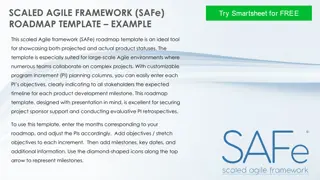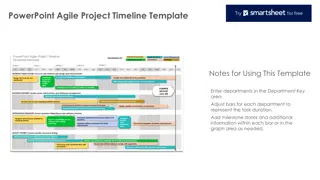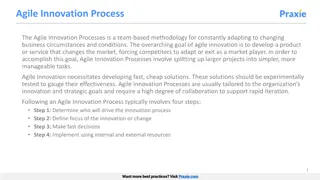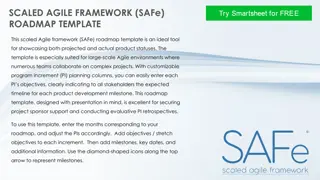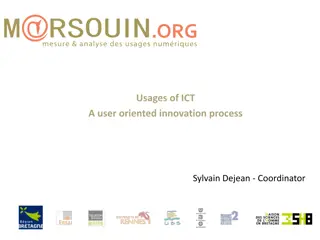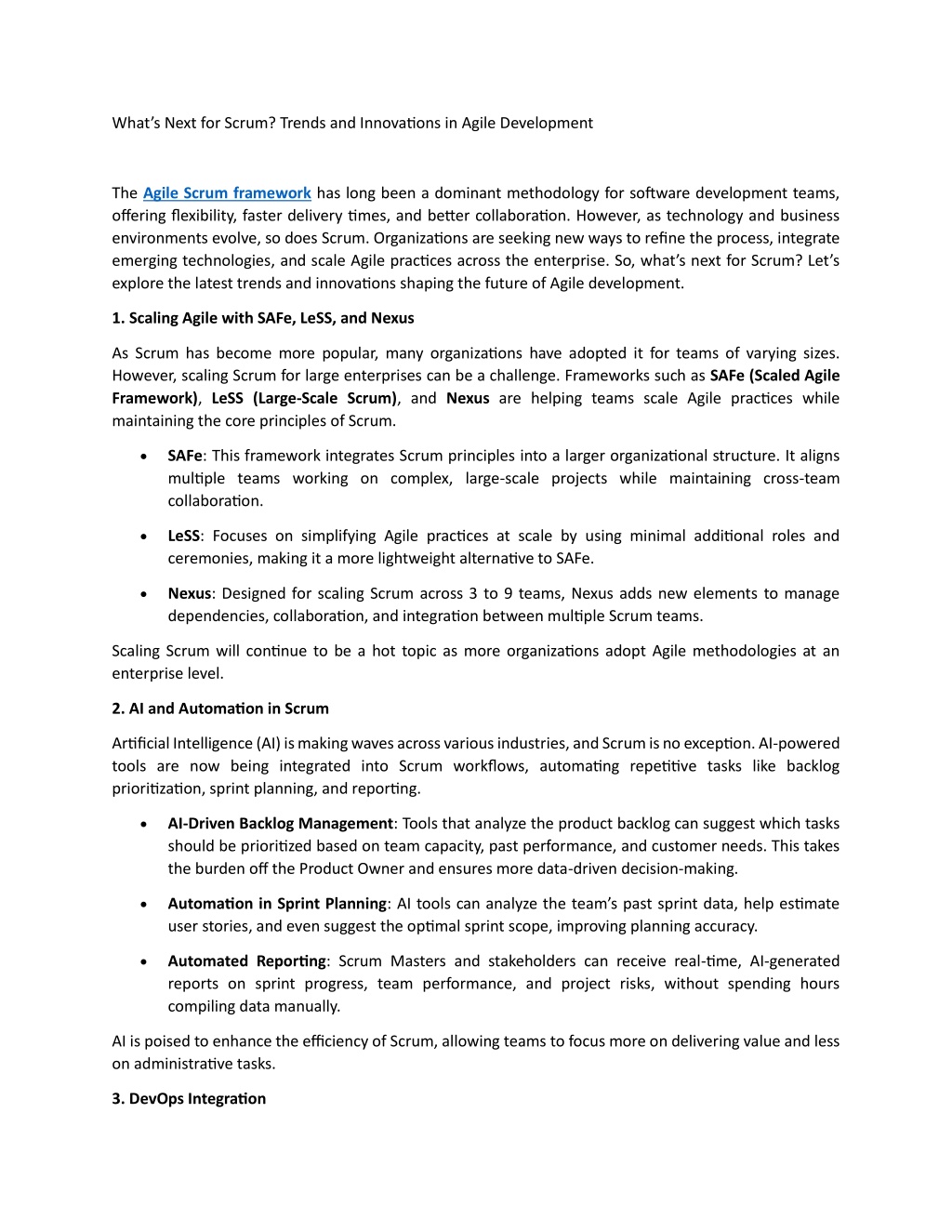
What’s Next for Scrum Trends and Innovations in Agile Development.docx
Yet, these tasks are often time-consuming and tedious, leading developers to either rush through them or avoid them altogether.
Download Presentation

Please find below an Image/Link to download the presentation.
The content on the website is provided AS IS for your information and personal use only. It may not be sold, licensed, or shared on other websites without obtaining consent from the author. Download presentation by click this link. If you encounter any issues during the download, it is possible that the publisher has removed the file from their server.
E N D
Presentation Transcript
Whats Next for Scrum? Trends and Innovations in Agile Development The Agile Scrum framework has long been a dominant methodology for software development teams, offering flexibility, faster delivery times, and better collaboration. However, as technology and business environments evolve, so does Scrum. Organizations are seeking new ways to refine the process, integrate emerging technologies, and scale Agile practices across the enterprise. So, what s next for Scrum? Let s explore the latest trends and innovations shaping the future of Agile development. 1. Scaling Agile with SAFe, LeSS, and Nexus As Scrum has become more popular, many organizations have adopted it for teams of varying sizes. However, scaling Scrum for large enterprises can be a challenge. Frameworks such as SAFe (Scaled Agile Framework), LeSS (Large-Scale Scrum), and Nexus are helping teams scale Agile practices while maintaining the core principles of Scrum. SAFe: This framework integrates Scrum principles into a larger organizational structure. It aligns multiple teams working on complex, large-scale projects while maintaining cross-team collaboration. LeSS: Focuses on simplifying Agile practices at scale by using minimal additional roles and ceremonies, making it a more lightweight alternative to SAFe. Nexus: Designed for scaling Scrum across 3 to 9 teams, Nexus adds new elements to manage dependencies, collaboration, and integration between multiple Scrum teams. Scaling Scrum will continue to be a hot topic as more organizations adopt Agile methodologies at an enterprise level. 2. AI and Automation in Scrum Artificial Intelligence (AI) is making waves across various industries, and Scrum is no exception. AI-powered tools are now being integrated into Scrum workflows, automating repetitive tasks like backlog prioritization, sprint planning, and reporting. AI-Driven Backlog Management: Tools that analyze the product backlog can suggest which tasks should be prioritized based on team capacity, past performance, and customer needs. This takes the burden off the Product Owner and ensures more data-driven decision-making. Automation in Sprint Planning: AI tools can analyze the team s past sprint data, help estimate user stories, and even suggest the optimal sprint scope, improving planning accuracy. Automated Reporting: Scrum Masters and stakeholders can receive real-time, AI-generated reports on sprint progress, team performance, and project risks, without spending hours compiling data manually. AI is poised to enhance the efficiency of Scrum, allowing teams to focus more on delivering value and less on administrative tasks. 3. DevOps Integration
As the lines between development and operations continue to blur, DevOps practices are becoming more closely integrated with Scrum. By embedding DevOps into the Agile workflow, teams can shorten feedback loops, automate testing, and deploy features faster. Continuous Integration/Continuous Delivery (CI/CD) pipelines are increasingly being adopted within Scrum teams to streamline deployments and maintain a constant flow of updates. DevOps practices help Scrum teams shift from delivering increments to achieving continuous delivery. This fosters faster feedback from stakeholders and end-users, allowing teams to adapt more rapidly. As Agile evolves, the combination of Scrum and DevOps is becoming a standard approach to ensure smooth, rapid releases without sacrificing quality. 4. Remote and Hybrid Scrum Teams With remote work becoming the new normal for many organizations, Scrum has had to adapt. Distributed teams are now leveraging digital tools and practices to maintain the effectiveness of Scrum ceremonies. Digital Scrum Tools: Platforms like Jira, Trello, and Microsoft Teams allow teams to manage sprints, track progress, and collaborate in real time, regardless of location. Asynchronous Standups: Remote teams often struggle with different time zones. Asynchronous standups allow team members to provide their updates via written or recorded formats rather than live meetings, offering more flexibility without losing communication. Virtual Sprint Reviews and Retrospectives: Tools like Miro and MURAL are being used to facilitate virtual retrospectives and sprint reviews, making them engaging and collaborative experiences for distributed teams. As remote work solidifies its place in the business world, Scrum teams will continue to adopt new practices to maintain collaboration and productivity in hybrid and distributed settings. 5. Focus on Agile Leadership The success of Scrum teams depends heavily on leadership that understands Agile values and principles. The role of Agile leadership is gaining more attention as organizations realize that cultural change is essential to making Scrum work effectively. Agile Coaching: Many organizations are investing in Agile coaches who can guide teams and leaders through the transition to Agile practices, fostering a culture of continuous improvement and self-organization. Servant Leadership: Scrum Masters and managers are embracing the concept of servant leadership, focusing on empowering teams to make decisions, remove obstacles, and drive their own success. As Agile becomes more mainstream, organizations are placing greater emphasis on leadership development to ensure the long-term success of their Scrum teams. Conclusion
Scrum is evolving to meet the needs of modern development teams. From scaling frameworks and AI integration to the rise of DevOps and remote collaboration, these trends will shape the future of Agile Scrum. As businesses continue to embrace Agile, these innovations will help Scrum teams remain efficient, adaptive, and ready to tackle the challenges of tomorrow. Read and.html More: https://techhorizonsolutions.blogspot.com/2024/09/whats-next-for-scrum-trends-




